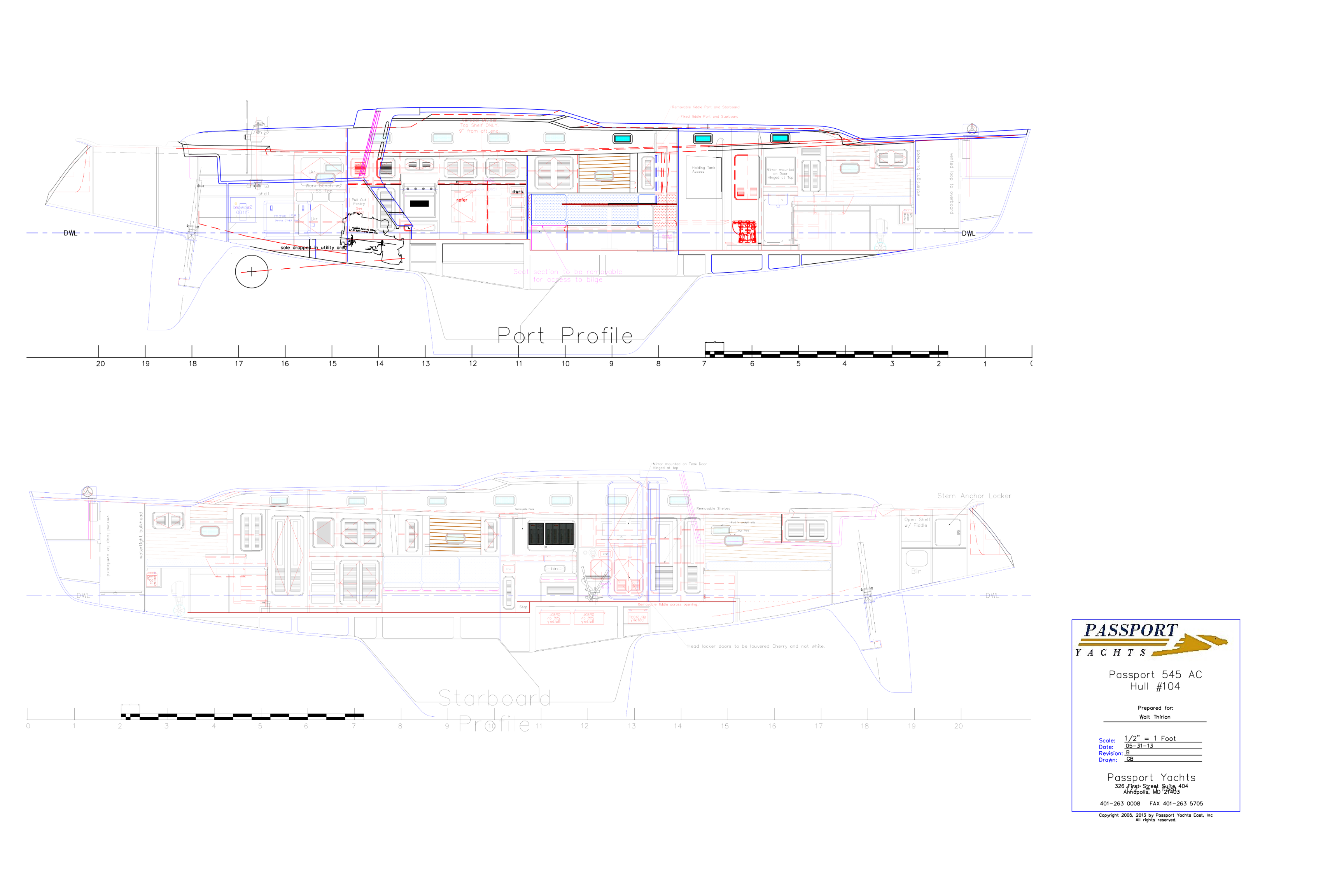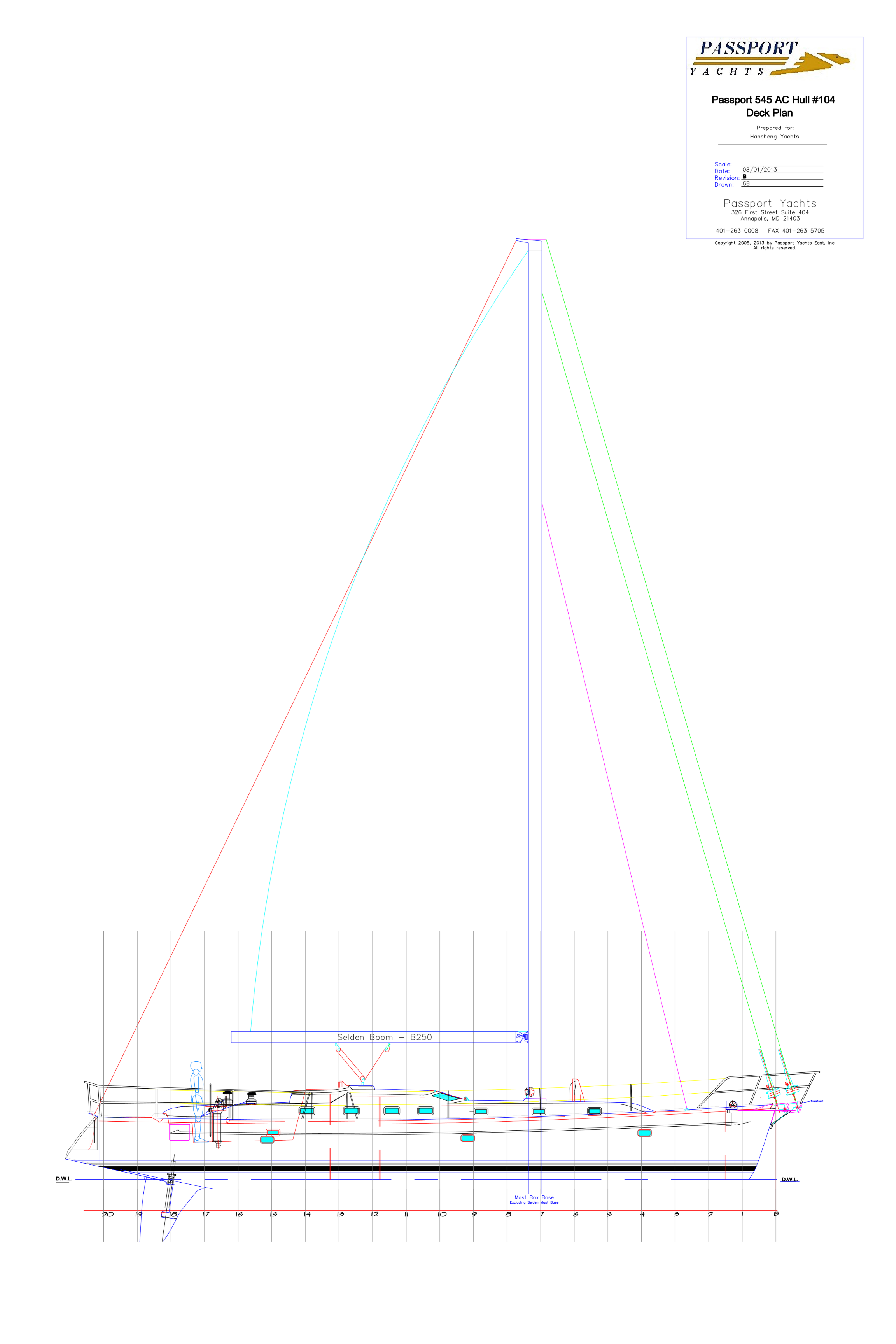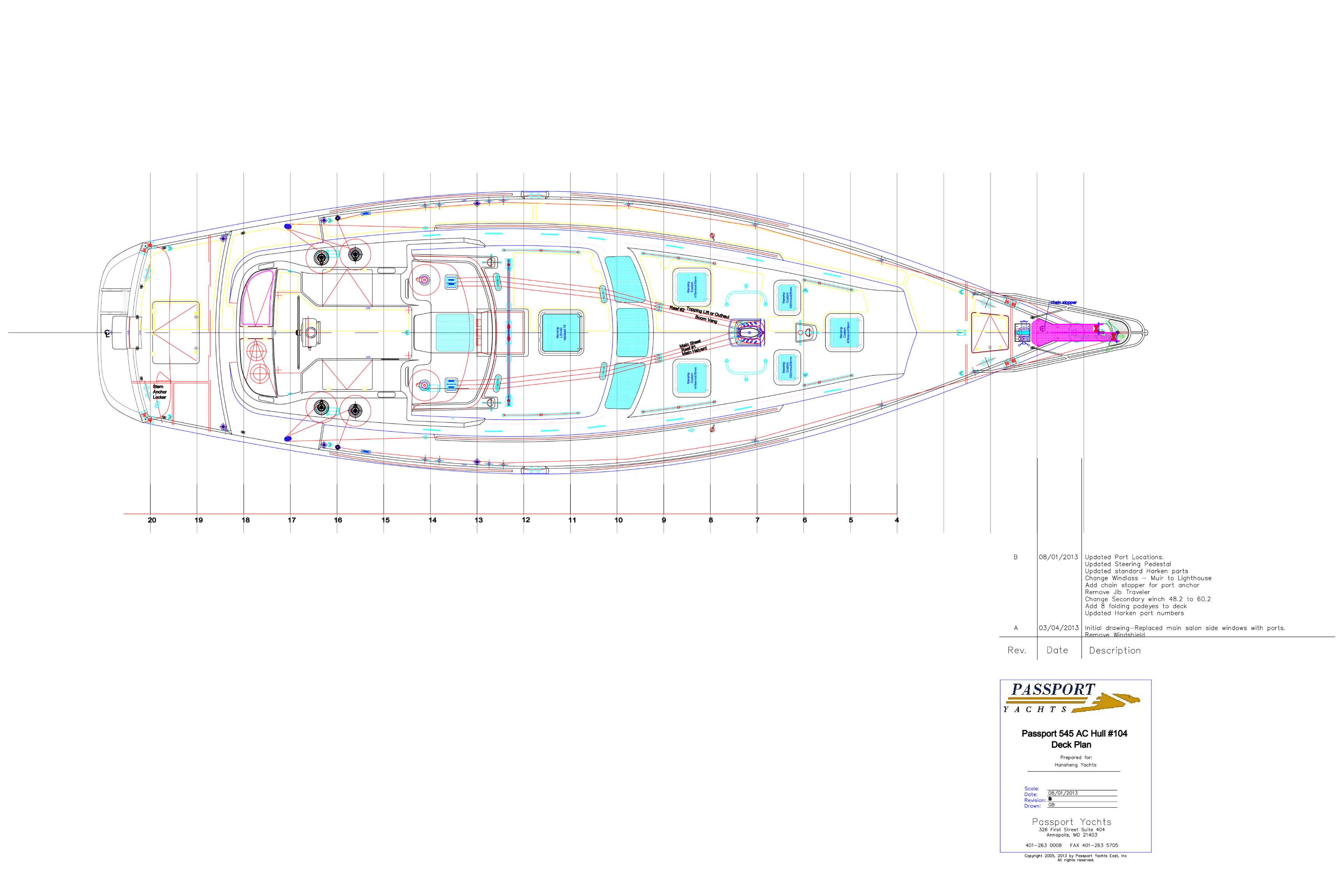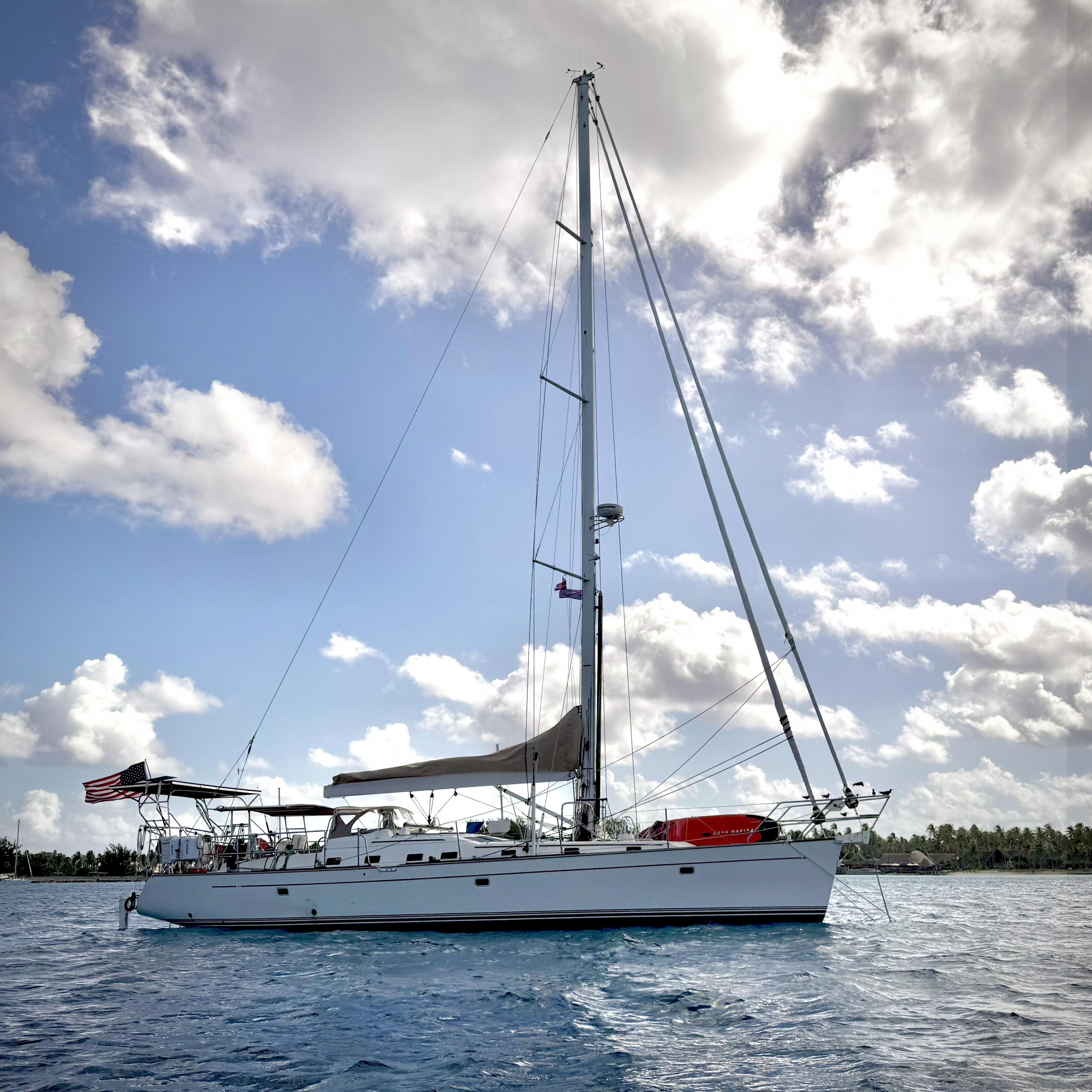SV Wanderlust
A True Bluewater Voyaging Sailboat
Introduction
Welcome aboard SV Wanderlust, our semi-custom, 2014 Passport 545 Aft Cockpit sailboat.
Sailing across oceans isn’t just a dream—it’s a test of preparation, design, and seamanship. For those aboard Wanderlust, it’s a reality made possible by decades of thoughtful design and robust construction. Conceived as a voyaging sailing vessel (“SV”) for short-handed crews, Wanderlust was built to cross oceans safely and comfortably, and she embodies what it means to be a true bluewater passagemaker.
Designed for the Ocean
While it is true that, with proper seamanship, almost any seaworthy vessel can undertake passages, Wanderlust was built for far more. Her strong hull, flexible sail plan, large fuel and water tanks, voluminous storage, robust systems, and functional interior layout make her perfectly suited to the rigors of crossing oceans.
As Blue Water Sailing noted in 2016:
”Passports have crossed every ocean and many have made fast and safe circumnavigations. And they have always done so with style. —Blue Water Sailing, April 2016
The Passport 545 is the product of a design partnership spanning decades between award-winning yacht designer Robert Perry and the Passport Design Group, led by Passport Yachts owner Thom Wagner and Graham Bowes. Perry—known for legendary bluewater cruisers like the Valiant 40 and Tayana 37—worked closely with Wagner to fine-tune every element of design, ultimately bringing the Passport 545 to life.
SV Wanderlust embodies this legacy with elegance and purpose. She is not merely a boat, but an artfully crafted instrument of exploration. As a 2014 model, she draws on a proven lineage of offshore cruisers while incorporating key advancements in hull form and rig design. With refined aesthetics and true liveaboard comfort, she reflects a deep understanding of what long-distance sailors really need. Every detail—every angle, system, and line—has been shaped by the input of voyagers who have spent months, even years, at sea.
In recognition of this outstanding design, Cruising World magazine named the Passport 545 Aft Cockpit the 2016 Best Full-Size Cruiser Over 50 Feet and awarded it the prestigious title of Overall 2016 Boat of the Year.

Hull
Wanderlust’s solid fiberglass hull, reinforced with aramid fibers, was built to endure the demands of repeated offshore passages.
Her low-aspect fin keel is integrally molded as part of the hull, encapsulating 14,700 pounds of lead ballast securely sealed in fiberglass. This ballast provides a low center of gravity and a powerful righting moment, giving the Passport 545AC her renowned stability and seakeeping in heavy weather.
A balanced skeg-mounted rudder, supported by an internal stainless-steel rudderpost, adds protection and strength. It ensures reliable steering and minimizes the risk of damage during long offshore passages or even an inadvertent grounding.
These fundamentals—solid fiberglass construction, deep ballast, and a protected rudder—are what make Wanderlust a dependable bluewater passagemaker, ready for the demands of serious offshore sailing.
Balanced Performance Under Sail

Wanderlust’s solent-rigged sloop sail plan provides the strength and versatility required for true bluewater voyaging. All major control lines are led aft, allowing safe sail handling from the cockpit and minimizing the need to go forward in heavy seas.
With a moderate displacement-to-length ratio, the Passport 545AC handles beautifully even in confused seas. Whether reaching in the trade winds or beating into a blow, she maintains a predictable, comfortable motion that builds confidence on long passages.
Spacious and Functional Cockpit
The aft cockpit offers plenty of room for both sail handling and everyday living. The long cockpit seats are comfortable for sitting or resting, and the cockpit table has two parts: a smaller section with folding leaves for use under sail, and a larger extension that comes out at anchor to seat six for a meal. Because the aft cockpit is lower and deeper than the center-cockpit version, it offers a greater sense of security in rough conditions. It’s a space that works underway, and one that naturally becomes the gathering place when Wanderlust is at anchor.
Interior Comforts for Long Passages
Essential Systems for Self-Sufficiency
Life aboard Wanderlust is built around simple, reliable systems that make long-term voyaging practical and sustainable. Fresh water comes from a 12-volt watermaker with dual pumps for redundancy. It’s deliberately manual—no computers or automation—so it can be repaired or adjusted at sea without specialized parts.
Refrigeration follows the same philosophy. A 12-volt, keel-cooled system keeps food cold efficiently, and we deliberately sail without a freezer. Past experience taught us that freezers consume large amounts of energy and often fail at critical times, leading to wasted provisions. Instead, we rely on time-tested preservation methods such as pressure canning and fermenting, and we stock up on canned goods when provisioning.
Together these choices mean Wanderlust can remain off-grid for extended periods without complicated, power-hungry equipment—an approach that favors dependability and self-sufficiency over unnecessary complexity.
Renewable and Redundant Power Generation
Wanderlust is designed to live comfortably off the grid without the constant drone of a generator. Her solar array—mounted on both the stern arch and bimini—supplies nearly all of her daily energy needs, even powering induction cooking appliances that reduce propane use to only occasional backup. As a result, propane tanks last for months rather than weeks.
While underway, a pair of Watt & Sea hydrogenerators provide additional renewable charging. Either unit can be deployed depending on heel angle, ensuring a steady supply of power on passage.
A generator and the Yanmar’s high-output alternator provide backup charging when needed, but unlike many modern “floating condos” that rely on running gensets for hours each day, Wanderlust typically needs hers only every few days—or briefly after dark when cooking on the induction burner. It’s a quiet, efficient system that supports sustainable long-term bluewater cruising.
Secure Galley at Sea
The U-shaped galley is designed for offshore use, with a single oversized sink for pots and pans, a gimbaled stove, and refrigeration that stays cold even when the boat is heeled. More than just a place to cook, it’s laid out so meals can be prepared safely in all conditions.

Ventilation
Wanderlust was built with airflow in mind, a detail that makes all the difference in warm climates. Six overhead hatches keep fresh air moving through the cabin whenever the trade winds are blowing, while our decision to replace the standard fixed sidelights with opening portlights gives every living space true cross-ventilation. The result is a boat that stays comfortable and livable at anchor in the tropics without relying on air conditioning—proof that good design and a few smart custom choices go a long way toward sustainable life aboard. And because the aft cockpit layout places the master cabin forward, it benefits from a very large overhead hatch and two opening portlights, making it one of the best-ventilated spaces on the boat.
Voluminous Storage
When you’re crossing an ocean there is nowhere to stop for supplies or spare parts, a fact that shapes how a voyaging yacht must be built. On Wanderlust, every possible space has been put to work for storage, enabling true self-sufficiency, extended passages, and off-grid living.
A massive aft lazarette swallows bulky gear and spare parts, while a forward lazarette behind the anchor chain locker holds dock lines, spare anchor rodes, and other gear needed for passagemaking close at hand. Deep bilges and an abundance of well-placed lockers throughout the interior allow months of provisions to be stowed, so crew and guests remain comfortable and well supplied no matter how far from port they venture.
Ground Tackle
For a voyaging sailboat, a reliable anchoring system is as important as the sails themselves. Wanderlust carries a 45 kg Ultra anchor—a modern spade-style design widely regarded as the most dependable for varied seabeds—set on 100 meters of 10 mm G4 chain, backed with 100 meters of nylon rode. This setup allows us to anchor securely even in deep water, with the confidence that comes from gear sized for the task.

A powerful windlass makes deployment and retrieval straightforward, while additional Fortress-style anchors and spare rodes are stored aft, ready when conditions call for them. Wanderlust’s anchoring system isn’t just about hardware—it’s about peace of mind. Whether we’re settled into a remote atoll or riding out a blow in a crowded harbor, her ground tackle lets us live securely on the hook, day after day.
Navigation and Communications
For centuries sailors crossed oceans with little more than a compass, sextant, and barometer—and Wanderlust still carries all three. Traditional tools remain reliable and independent of electricity, but modern systems add important layers of safety.
Our primary navigation comes from a dedicated GPS unit chosen for its reliability, with the chartplotter’s integrated GPS serving as backup. Radar, AIS, and a full suite of instruments provide additional awareness of position and traffic, especially in poor visibility. Communications are equally redundant. Starlink serves as the primary system, delivering real-time weather data and contact with shore. Offshore, Iridium and SSB radios ensure we remain connected even if satellite broadband fails, with voice, text, and email capability when needed.
None of these tools replace seamanship, but together they reduce uncertainty and expand our margins of safety—helping us make sound decisions on long voyages while still relying on the skills sailors have trusted for generations.
Why Wanderlust
SV Wanderlust is more than a collection of specifications and systems. She is the vessel that carries us across oceans, shelters us in far-off anchorages, and makes it possible to live simply and fully at sea. Every design choice, from her strong hull and versatile rig to her self-sufficient power and water systems, reflects a philosophy of voyaging that values reliability, safety, and independence.
For us, she is not just a sailboat, but a trusted partner in exploration. Wanderlust embodies the freedom to cross oceans under our own power, the confidence to weather rough conditions, and the comfort to call remote anchorages home. She represents what a true bluewater passagemaker should be—capable of sustained bluewater cruising without reliance on shore.
If you’d like to see where she carries us, you can see our current position or read the stories from our life aboard.
Specifications
Basics
- LOA: 54.5 ft (16.6m)
- Length at waterline: 45.47 ft (13.9m)
- Beam: 15.15 ft (4.6m)
- Draft: 6.75 ft (2.1m)
- Ballast: 14,700# (6,682 kg)
- Displacement
- Dry: 38,500# (17,500 kg)
- With full fuel, water, provisioned, outfitted for cruising: ~45,000# (~20,455 kg)
- Fuel Capacity: 376 gal (1,421 L)
- Water Capacity: 205 gal (775 L)
Sail Plan—Solent-rigged Sloop
- Mainsail
- Full-battened, classic aramid reinforced
- Quantum Sails
- Sail area: 756 ft2 (70.23 m2)
- Two reefs, both single-line—both reef points deeper than standard, first reef equal to about 1 ½ standard and second reef equal to 3rd standard reef
- Working jib—on inner “solent” stay
- Quantum Fusion M M6 Furling Jib
- Sail area: 524 ft2 (48.7 m2)
- Furled on Furlex 400
- Code 0—on outer head stay
- Quantum Code 0 Asymmetrical AWA 60 reaching sail
- Sail area: 957 ft2 (88.94 m2)
- Perfect for AWA of 60° - 120°
- Furled on Furlex 400
- Storm sails
- Storm jib can be deployed on stowable inner forestay
- Storm trysail on secondary mast track
Engine & Propulsion
- Yanmar 110HP (80.9kW) 4JH4-HTE 4-cylinder, turbocharged and intercooled diesel
- Hurth Marine ZF 63 IV 12° “V” drive transmission
- Max-Prop Easy 3-blade feathering propeller
- Bow thruster
- Total fuel capacity of 376 Gal (1,422L) in three separate fuel tanks: 170 Gal (643L), 125 Gal (473L), and 81Gal (306L)
- Dual Racor 500 fuel filters with crossover valves
Ground Tackle
- Primary anchor: 99# (45kg) spade style Ultra anchor
- Primary rode: 328 ft (100m) of 3/8 in (10mm) G4 chain backed with 328 ft (100m) of 5/8 in (17mm) nylon rode
- Muir Storm 3500 vertical windlass
- 328 ft (100m) of 5/8 in (17mm) nylon rode in stern anchor locker
- Two Fortress anchors stowed in aft lazarette
SOLAS (Safety of Life At Sea) and Emergency Equipment
- ACR Global Fix 406MHz EPIRB
- Revere 6-person ocean certified life raft
- Ditch bag with hand-held VHF, solar charger, Garmin inReach Satellite communicator
- SOLAS Flares
- 5 ABC fire extinguishers located in strategic locations
- VHF and SSB equipped with Distress DSC capability
- Two level bilge pump system with higher pump alarm
- Manual bilge pump
- Class A (ocean) PFDs
- Inflatable PFDs with harnesses
- Watertight bulkhead between V-berth and forward lazarette
- Pad eyes and other tether points in cockpit plus pad eyes for jacklines when offshore
Electronics
- Instruments
- Raymarine Axiom 2 Pro 12 S chartplotter
- Raymarine RS-150 GPS
- Two Raymarine i70 color displays in cockpit
- One Raymarine i70 color display at nav station
- Raymarine ITC-5 Analog to NMEA converter (puts wind data on NMEA bus)
- Raymarine AIS700 Class B Transceiver
- Raymarine RD424HD Color Radar
- Communications
- Starlink v3 flat standard terminal with 12 volt supply conversion
- ICOM IC-M510 EVO VHF with integrated AIS receiver and exterior speaker/hailer
- Iridium GO satellite communicator
- ICOM IC-M802 SSB with Pactor modem
- Autopilot
- Raymarine p70 color autopilot control head
- Raymarine Evolution EV1 Sensor Core
- Raymarine ACU-400 Evolution autopilot actuator control unit
- Raymarine Type 3 Hydraulic Linear Drive
Electrical Systems
- Renewable and redundant charging systems
- 1870W solar panel system
- split into two systems, each with a dedicated MPPT charge controller
- 1320W Suntech N-Type Monocrystalline Bifacial solar panels on stern arch
- 550W of flexible solar panels on bimini
- Two stern-mounted Watt & Sea Cruising 600 hydrogenerators
- Mase IS8.1 8kW diesel generator
- Balmar 160A alternator with smart regulator on main engine
- 1870W solar panel system
- 12 Volt subsystem
- Powers all instruments, internal LED lights, pumps, etc.
- Victron Cerbo GX for monitoring/reporting
- Victron MultiPlus 12/3000/120 inverter/charger
- Victron 500A SmartShunt for system monitoring
- Victron SmartSolar Charger MPPT 150/45 for bimini panels
- Victron SmartSolar Charger MPPT 150/100 for stern arch panels
- 30A DC-DC charger to charge thruster battery from house bank
- 30A DC-DC charger to charge engine starting battery from house bank
- Four Full River 260AH AGM batteries in house bank for a total of 1040AH
- Two deep cycle AGM batteries forward for anchor windlass and bow thruster
- One deep cycle starting battery for main diesel and generator
- 120 Volt subsystem
- Powered by MultiPlus inverter/charger, Mase generator or shore power
- 10,000 BTU AC/Heat in forward master cabin
- 15,000 BTU AC/Heat for main salon and quarter berth
- 10 Gal (37.8 L), 1400W hot water tank/heater—also heated by main diesel cooling system
- 120V outlets throughout boat
- Shore Power: 240V/50A, Galvanically isolated
Miscellaneous Systems
- Spectra Cape Horn Xtreme 14GPH (52.9 L) watermaker with dual, redundant 12V pumps
- 205 Gal (775L) of fresh water in two separate tanks: 105 Gal (397L) port tank, 100 Gal (378L) starboard tank
- Fresh water foot pump at galley sink
- Saltwater foot pump at galley sink
- Princess Gourmet II 3-burner propane stove and oven
- Built-in, keel-cooled refrigerator with Frigo smart compressor and controller